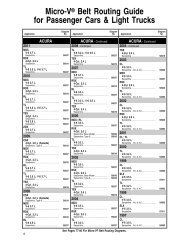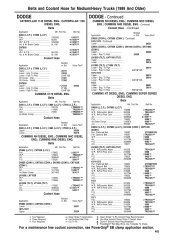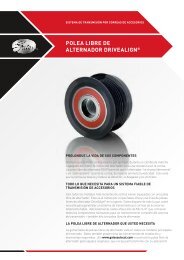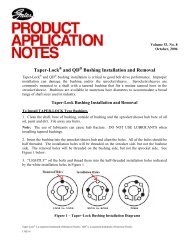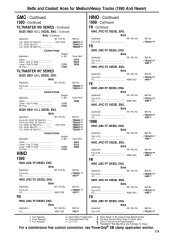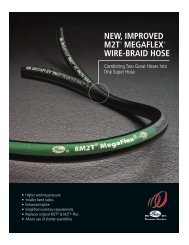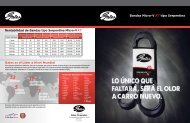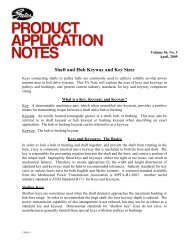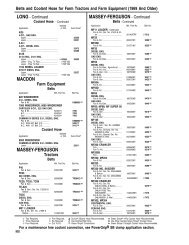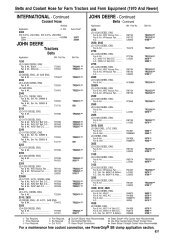PowerGrip® GT® Belt Drives
PowerGrip® GT® Belt Drives
PowerGrip® GT® Belt Drives
Create successful ePaper yourself
Turn your PDF publications into a flip-book with our unique Google optimized e-Paper software.
Polyflex ® JB ® and Micro-V ® <strong>Belt</strong>s – Engineering<br />
IV.<strong>Belt</strong> Tensioning – continued<br />
Formula 15<br />
(PD) (RPM)<br />
V =<br />
19100<br />
, m/s<br />
Table 39 – Factor m, Y and Minimum<br />
Tst (Metric)<br />
Cross Section m Y *Minimum T st (Newtons)<br />
5M Polyflex JB 0.009 2.2 35.0<br />
J Micro-V 0.006 1.03 12.5<br />
Formula 19 – Metric Units<br />
( )<br />
t<br />
T st +<br />
Deflection Force per strand, Min. = Le<br />
25<br />
Formula 20 – Metric Units<br />
Y<br />
( )<br />
t<br />
1.5 T st + Y<br />
Deflection Force per strand, Max. = Le , N<br />
25<br />
, N<br />
Step 3. Minimum and maximum deflection<br />
forces are calculated on a per<br />
strand or rib basis. The values in Step<br />
2 should be multiplied by the number of<br />
strands in the belt which is being<br />
deflected. For example, if a 3-strand<br />
Polyflex JB belt is to be deflected, the<br />
minimum and maximum deflection forces<br />
should be multiplied by 3.<br />
*If the value of T st , calculated in Step 1, is less than the Minimum<br />
Tst in Table 38 or 39, use the Minimum T st value from the table for<br />
T st to calculate Minimum and Maximum deflection forces in Step<br />
2. The minimum value must be used on lightly loaded drives due<br />
to belt stiffness so the belt will properly conform to the sheave.<br />
Step 2. Calculate the minimum and<br />
maximum recommended deflection<br />
forces per strand.<br />
A. Measure the span length (t) on the drive or<br />
calculate span length (t) using the formula<br />
below:<br />
Formula 16<br />
2<br />
[ ( ) ]<br />
t = CD 1 – 0.125<br />
D–d<br />
CD<br />
Where: t = Span length, inches<br />
CD = Center distance, inches<br />
D = Large sheave or pulley diameter, inches<br />
d = Small sheave diameter, inches<br />
B. If the drive uses only a single, 2 or 3-strand<br />
Polyflex JB belt, calculate the minimum and<br />
maximum recommended deflection force using<br />
these formulas.<br />
Formula 17 – English Units<br />
Deflection Force per strand, Min. =<br />
( )<br />
t<br />
T st +<br />
Le<br />
16<br />
Y<br />
, lb.<br />
Formula 18 – English Units<br />
t<br />
1.5 T st + ( ) Y<br />
Deflection Force per strand, Max. =<br />
Le , lb.<br />
16<br />
Where: Tst =Static tension per strand from Step 1.<br />
Y = Constant from Table 38.<br />
t = Span length, inches<br />
Le = Effective <strong>Belt</strong> length, inches<br />
Where: T st =Static tension per strand from Step 1.<br />
Y = Constant from Table 39.<br />
t = Span length, millimeters<br />
Le = Effective <strong>Belt</strong> length, millimeters<br />
C. If the drive uses two or more, 2 or 3-strand<br />
Polyflex JB belts (should be matched sets),<br />
calculate the minimum and maximum<br />
recommended deflection forces using the<br />
formula below:<br />
Formula 21 – English Units<br />
Deflection Force per strand, Min. =<br />
T st + Y<br />
16<br />
, lb.<br />
Formula 22 – English Units<br />
Deflection Force per strand, Max. =<br />
1.5 T st + Y<br />
16<br />
Where: Tst =Static tension per strand from Step 1.<br />
Y = Constant from Table 38.<br />
Formula 23 – Metric Units<br />
T st + Y<br />
Deflection Force per strand, Min. =<br />
25<br />
, N<br />
, lb.<br />
Formula 24 – Metric Units<br />
1.5 T st + Y<br />
Deflection Force per strand, Max. =<br />
25<br />
, N<br />
Where: Tst =Static tension per strand from Step 1.<br />
Y = Constant from Table 39.<br />
Step 4. Calculate the deflection distance.<br />
The force deflection procedure is based on the<br />
following belt span deflection distances:<br />
Formula 25<br />
t<br />
t<br />
Deflection distance =<br />
64<br />
, inches; or = , mm<br />
100<br />
Where: t = Span lengths<br />
Step 5. Apply the tension.<br />
A. Midway between the belt contact points on the<br />
two sheaves, apply a force perpendicular to the<br />
belt large enough to deflect it from its normal<br />
position by the amount calculated in Step 4. Be<br />
sure the force is distributed evenly across the<br />
belt top width. When pushing on a multiple<br />
strand belt, for example, it may be necessary to<br />
use a bar under the gauge to distribute the force<br />
equally on all strands. (This force can be<br />
applied by pushing the belt in or pulling it out.)<br />
At least one sheave should be free to rotate.<br />
B. Compare this deflection force with the range of<br />
forces calculated in Step 3.<br />
1. If this force is less than the recommended<br />
minimum, the belt should be tightened.<br />
2. If this force is more than the recommended<br />
maximum, the belt should be loosened.<br />
Ideally, the maximum deflection force should be<br />
used when installing the belts and they should be<br />
retensioned when the deflection force falls below the<br />
minimum value calculated in Step 2.<br />
The World’s Most Trusted Name in <strong>Belt</strong>s, Hose & Hydraulics.<br />
79




